International Business: Biotechnology Funding and Innovation Partners
VerifiedAdded on 2020/05/28
|10
|2070
|79
Essay
AI Summary
This essay provides a comprehensive overview of the biotechnology industry, focusing on its key activities, major players, and the significance of the UK market. It delves into the industry's reliance on research and development and its sub-industries, including healthcare, energy & industrial, and agriculture. The essay explores potential sources of external funding for biotechnology startups, such as government grants, venture philanthropy, and partnerships with universities and pharma companies. Furthermore, it examines the reasons for collaboration with external partners for innovation, including upstream suppliers, downstream customers, and research institutes. The essay also outlines the process of selecting innovation partners, emphasizing factors such as innovativeness, financial exposure, previous alliance experience, and convergent expectations. The conclusion reiterates the industry's focus on developing new technologies for medicine and agriculture and the importance of strategic partnerships for success. This essay is a valuable resource for anyone interested in understanding the complexities and opportunities within the biotechnology sector.
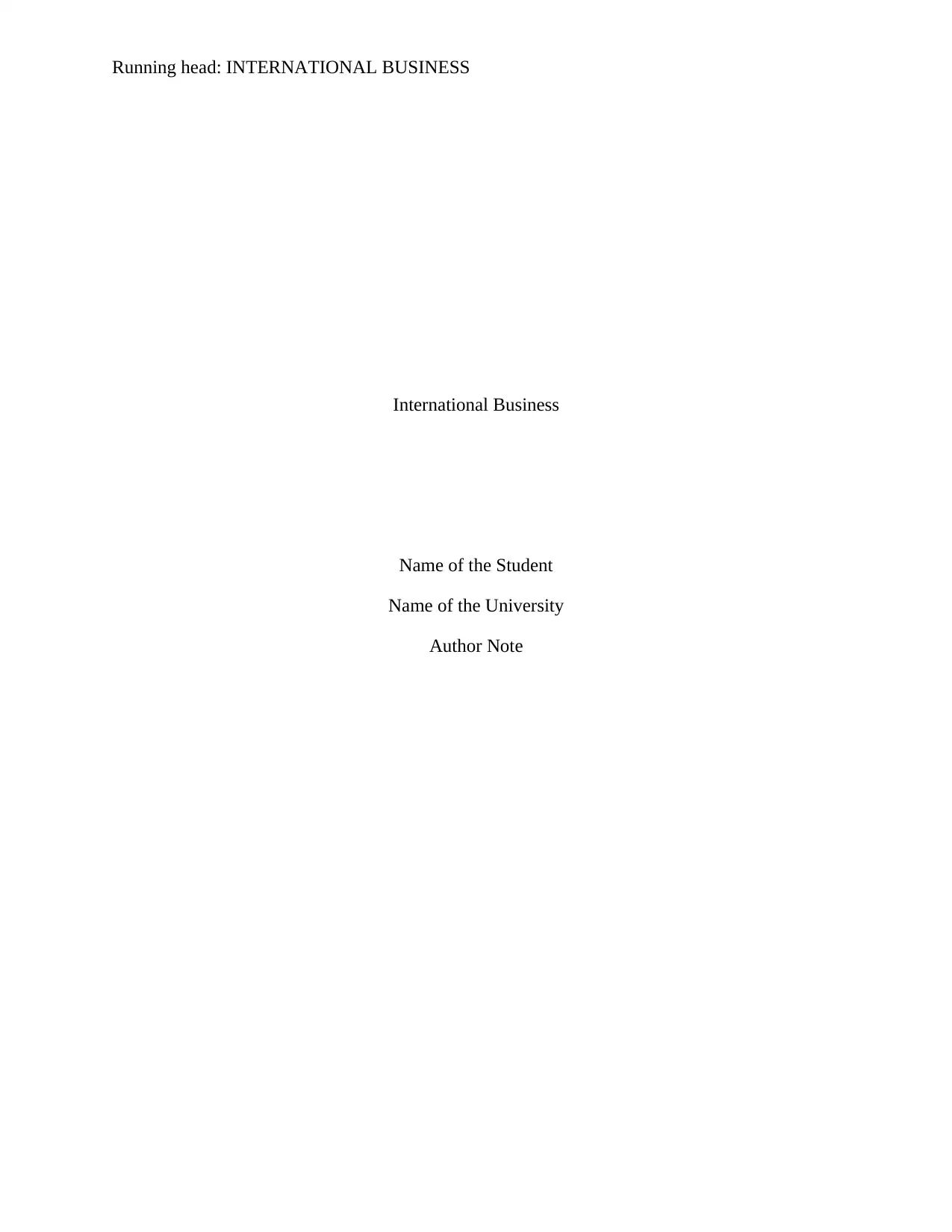
Running head: INTERNATIONAL BUSINESS
International Business
Name of the Student
Name of the University
Author Note
International Business
Name of the Student
Name of the University
Author Note
Paraphrase This Document
Need a fresh take? Get an instant paraphrase of this document with our AI Paraphraser
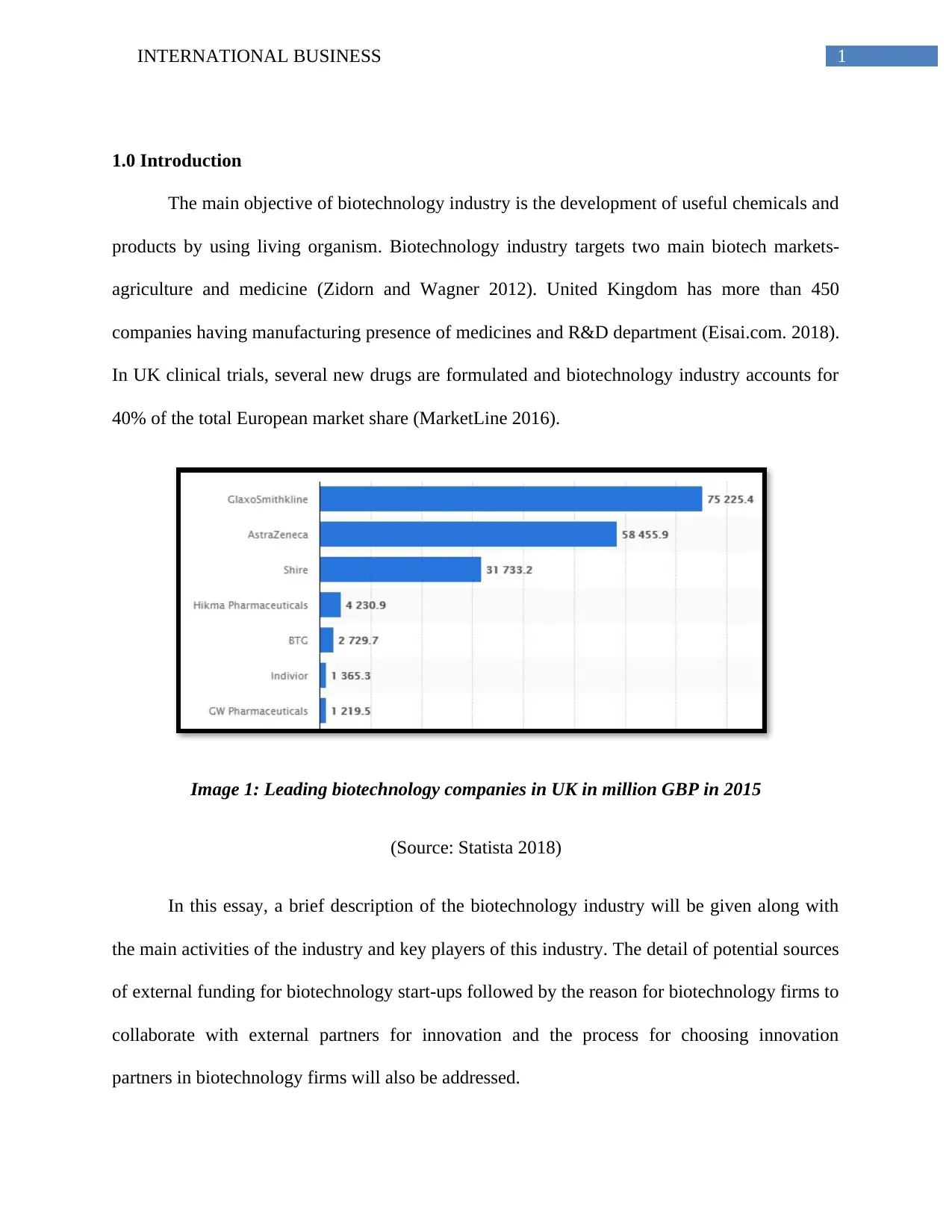
1INTERNATIONAL BUSINESS
1.0 Introduction
The main objective of biotechnology industry is the development of useful chemicals and
products by using living organism. Biotechnology industry targets two main biotech markets-
agriculture and medicine (Zidorn and Wagner 2012). United Kingdom has more than 450
companies having manufacturing presence of medicines and R&D department (Eisai.com. 2018).
In UK clinical trials, several new drugs are formulated and biotechnology industry accounts for
40% of the total European market share (MarketLine 2016).
Image 1: Leading biotechnology companies in UK in million GBP in 2015
(Source: Statista 2018)
In this essay, a brief description of the biotechnology industry will be given along with
the main activities of the industry and key players of this industry. The detail of potential sources
of external funding for biotechnology start-ups followed by the reason for biotechnology firms to
collaborate with external partners for innovation and the process for choosing innovation
partners in biotechnology firms will also be addressed.
1.0 Introduction
The main objective of biotechnology industry is the development of useful chemicals and
products by using living organism. Biotechnology industry targets two main biotech markets-
agriculture and medicine (Zidorn and Wagner 2012). United Kingdom has more than 450
companies having manufacturing presence of medicines and R&D department (Eisai.com. 2018).
In UK clinical trials, several new drugs are formulated and biotechnology industry accounts for
40% of the total European market share (MarketLine 2016).
Image 1: Leading biotechnology companies in UK in million GBP in 2015
(Source: Statista 2018)
In this essay, a brief description of the biotechnology industry will be given along with
the main activities of the industry and key players of this industry. The detail of potential sources
of external funding for biotechnology start-ups followed by the reason for biotechnology firms to
collaborate with external partners for innovation and the process for choosing innovation
partners in biotechnology firms will also be addressed.
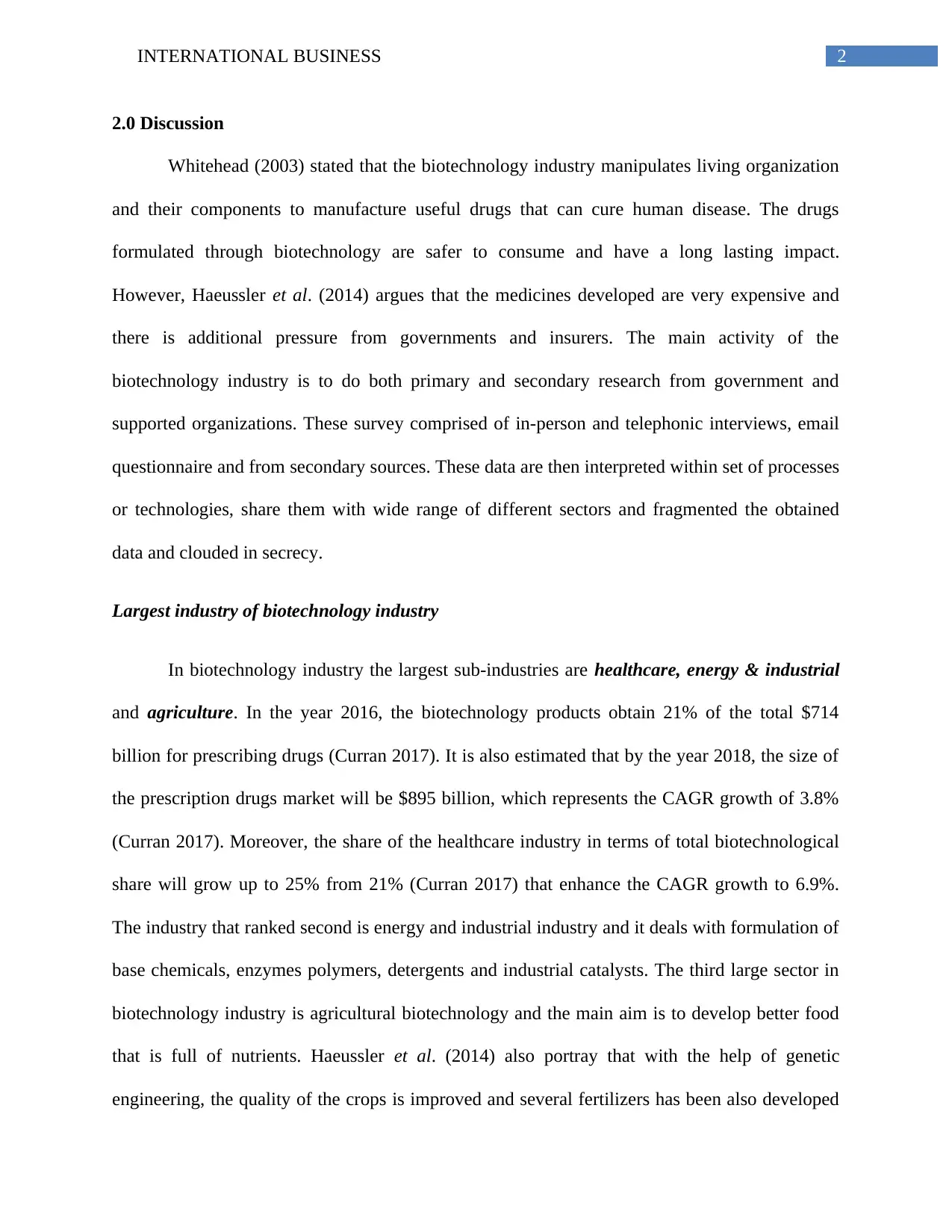
2INTERNATIONAL BUSINESS
2.0 Discussion
Whitehead (2003) stated that the biotechnology industry manipulates living organization
and their components to manufacture useful drugs that can cure human disease. The drugs
formulated through biotechnology are safer to consume and have a long lasting impact.
However, Haeussler et al. (2014) argues that the medicines developed are very expensive and
there is additional pressure from governments and insurers. The main activity of the
biotechnology industry is to do both primary and secondary research from government and
supported organizations. These survey comprised of in-person and telephonic interviews, email
questionnaire and from secondary sources. These data are then interpreted within set of processes
or technologies, share them with wide range of different sectors and fragmented the obtained
data and clouded in secrecy.
Largest industry of biotechnology industry
In biotechnology industry the largest sub-industries are healthcare, energy & industrial
and agriculture. In the year 2016, the biotechnology products obtain 21% of the total $714
billion for prescribing drugs (Curran 2017). It is also estimated that by the year 2018, the size of
the prescription drugs market will be $895 billion, which represents the CAGR growth of 3.8%
(Curran 2017). Moreover, the share of the healthcare industry in terms of total biotechnological
share will grow up to 25% from 21% (Curran 2017) that enhance the CAGR growth to 6.9%.
The industry that ranked second is energy and industrial industry and it deals with formulation of
base chemicals, enzymes polymers, detergents and industrial catalysts. The third large sector in
biotechnology industry is agricultural biotechnology and the main aim is to develop better food
that is full of nutrients. Haeussler et al. (2014) also portray that with the help of genetic
engineering, the quality of the crops is improved and several fertilizers has been also developed
2.0 Discussion
Whitehead (2003) stated that the biotechnology industry manipulates living organization
and their components to manufacture useful drugs that can cure human disease. The drugs
formulated through biotechnology are safer to consume and have a long lasting impact.
However, Haeussler et al. (2014) argues that the medicines developed are very expensive and
there is additional pressure from governments and insurers. The main activity of the
biotechnology industry is to do both primary and secondary research from government and
supported organizations. These survey comprised of in-person and telephonic interviews, email
questionnaire and from secondary sources. These data are then interpreted within set of processes
or technologies, share them with wide range of different sectors and fragmented the obtained
data and clouded in secrecy.
Largest industry of biotechnology industry
In biotechnology industry the largest sub-industries are healthcare, energy & industrial
and agriculture. In the year 2016, the biotechnology products obtain 21% of the total $714
billion for prescribing drugs (Curran 2017). It is also estimated that by the year 2018, the size of
the prescription drugs market will be $895 billion, which represents the CAGR growth of 3.8%
(Curran 2017). Moreover, the share of the healthcare industry in terms of total biotechnological
share will grow up to 25% from 21% (Curran 2017) that enhance the CAGR growth to 6.9%.
The industry that ranked second is energy and industrial industry and it deals with formulation of
base chemicals, enzymes polymers, detergents and industrial catalysts. The third large sector in
biotechnology industry is agricultural biotechnology and the main aim is to develop better food
that is full of nutrients. Haeussler et al. (2014) also portray that with the help of genetic
engineering, the quality of the crops is improved and several fertilizers has been also developed
⊘ This is a preview!⊘
Do you want full access?
Subscribe today to unlock all pages.

Trusted by 1+ million students worldwide
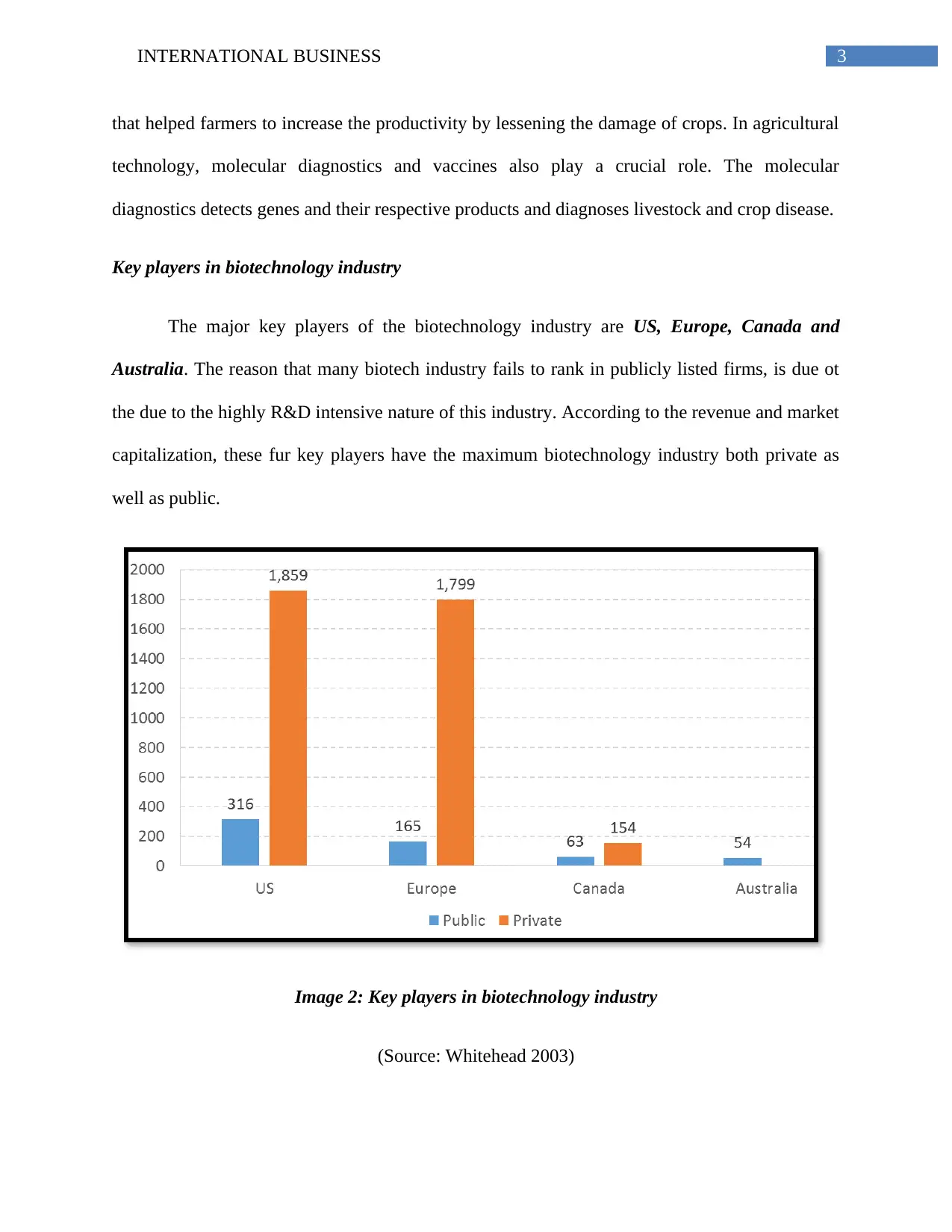
3INTERNATIONAL BUSINESS
that helped farmers to increase the productivity by lessening the damage of crops. In agricultural
technology, molecular diagnostics and vaccines also play a crucial role. The molecular
diagnostics detects genes and their respective products and diagnoses livestock and crop disease.
Key players in biotechnology industry
The major key players of the biotechnology industry are US, Europe, Canada and
Australia. The reason that many biotech industry fails to rank in publicly listed firms, is due ot
the due to the highly R&D intensive nature of this industry. According to the revenue and market
capitalization, these fur key players have the maximum biotechnology industry both private as
well as public.
Image 2: Key players in biotechnology industry
(Source: Whitehead 2003)
that helped farmers to increase the productivity by lessening the damage of crops. In agricultural
technology, molecular diagnostics and vaccines also play a crucial role. The molecular
diagnostics detects genes and their respective products and diagnoses livestock and crop disease.
Key players in biotechnology industry
The major key players of the biotechnology industry are US, Europe, Canada and
Australia. The reason that many biotech industry fails to rank in publicly listed firms, is due ot
the due to the highly R&D intensive nature of this industry. According to the revenue and market
capitalization, these fur key players have the maximum biotechnology industry both private as
well as public.
Image 2: Key players in biotechnology industry
(Source: Whitehead 2003)
Paraphrase This Document
Need a fresh take? Get an instant paraphrase of this document with our AI Paraphraser
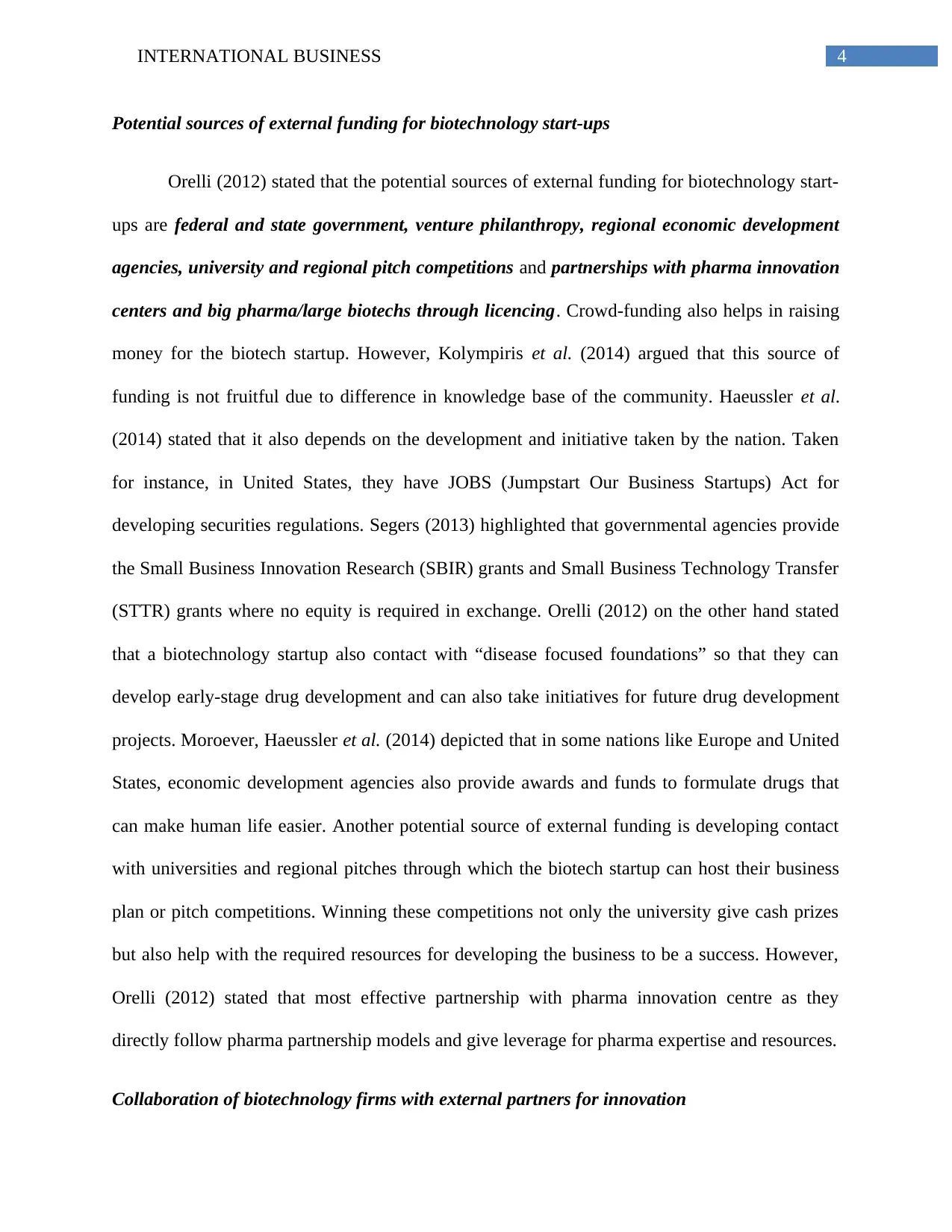
4INTERNATIONAL BUSINESS
Potential sources of external funding for biotechnology start-ups
Orelli (2012) stated that the potential sources of external funding for biotechnology start-
ups are federal and state government, venture philanthropy, regional economic development
agencies, university and regional pitch competitions and partnerships with pharma innovation
centers and big pharma/large biotechs through licencing. Crowd-funding also helps in raising
money for the biotech startup. However, Kolympiris et al. (2014) argued that this source of
funding is not fruitful due to difference in knowledge base of the community. Haeussler et al.
(2014) stated that it also depends on the development and initiative taken by the nation. Taken
for instance, in United States, they have JOBS (Jumpstart Our Business Startups) Act for
developing securities regulations. Segers (2013) highlighted that governmental agencies provide
the Small Business Innovation Research (SBIR) grants and Small Business Technology Transfer
(STTR) grants where no equity is required in exchange. Orelli (2012) on the other hand stated
that a biotechnology startup also contact with “disease focused foundations” so that they can
develop early-stage drug development and can also take initiatives for future drug development
projects. Moroever, Haeussler et al. (2014) depicted that in some nations like Europe and United
States, economic development agencies also provide awards and funds to formulate drugs that
can make human life easier. Another potential source of external funding is developing contact
with universities and regional pitches through which the biotech startup can host their business
plan or pitch competitions. Winning these competitions not only the university give cash prizes
but also help with the required resources for developing the business to be a success. However,
Orelli (2012) stated that most effective partnership with pharma innovation centre as they
directly follow pharma partnership models and give leverage for pharma expertise and resources.
Collaboration of biotechnology firms with external partners for innovation
Potential sources of external funding for biotechnology start-ups
Orelli (2012) stated that the potential sources of external funding for biotechnology start-
ups are federal and state government, venture philanthropy, regional economic development
agencies, university and regional pitch competitions and partnerships with pharma innovation
centers and big pharma/large biotechs through licencing. Crowd-funding also helps in raising
money for the biotech startup. However, Kolympiris et al. (2014) argued that this source of
funding is not fruitful due to difference in knowledge base of the community. Haeussler et al.
(2014) stated that it also depends on the development and initiative taken by the nation. Taken
for instance, in United States, they have JOBS (Jumpstart Our Business Startups) Act for
developing securities regulations. Segers (2013) highlighted that governmental agencies provide
the Small Business Innovation Research (SBIR) grants and Small Business Technology Transfer
(STTR) grants where no equity is required in exchange. Orelli (2012) on the other hand stated
that a biotechnology startup also contact with “disease focused foundations” so that they can
develop early-stage drug development and can also take initiatives for future drug development
projects. Moroever, Haeussler et al. (2014) depicted that in some nations like Europe and United
States, economic development agencies also provide awards and funds to formulate drugs that
can make human life easier. Another potential source of external funding is developing contact
with universities and regional pitches through which the biotech startup can host their business
plan or pitch competitions. Winning these competitions not only the university give cash prizes
but also help with the required resources for developing the business to be a success. However,
Orelli (2012) stated that most effective partnership with pharma innovation centre as they
directly follow pharma partnership models and give leverage for pharma expertise and resources.
Collaboration of biotechnology firms with external partners for innovation
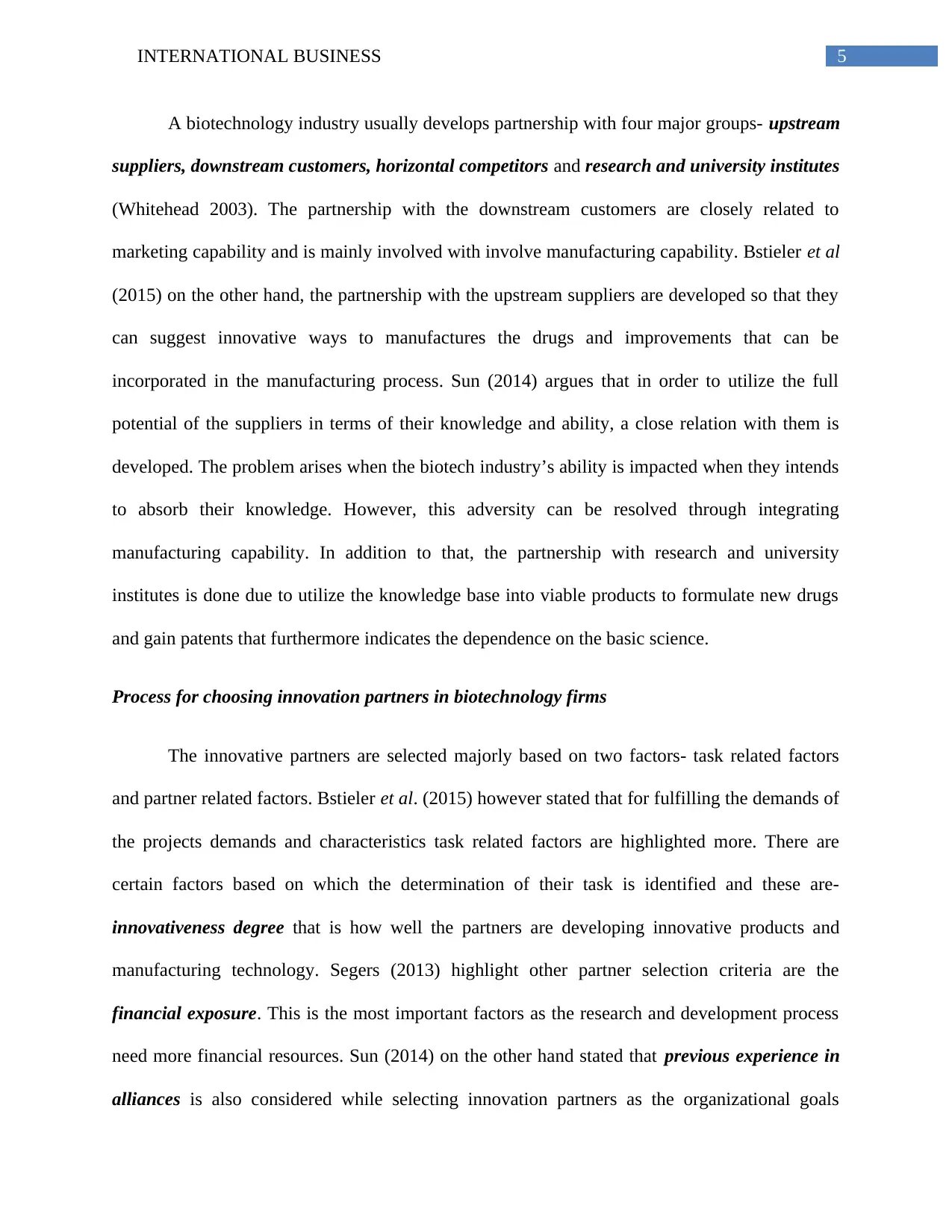
5INTERNATIONAL BUSINESS
A biotechnology industry usually develops partnership with four major groups- upstream
suppliers, downstream customers, horizontal competitors and research and university institutes
(Whitehead 2003). The partnership with the downstream customers are closely related to
marketing capability and is mainly involved with involve manufacturing capability. Bstieler et al
(2015) on the other hand, the partnership with the upstream suppliers are developed so that they
can suggest innovative ways to manufactures the drugs and improvements that can be
incorporated in the manufacturing process. Sun (2014) argues that in order to utilize the full
potential of the suppliers in terms of their knowledge and ability, a close relation with them is
developed. The problem arises when the biotech industry’s ability is impacted when they intends
to absorb their knowledge. However, this adversity can be resolved through integrating
manufacturing capability. In addition to that, the partnership with research and university
institutes is done due to utilize the knowledge base into viable products to formulate new drugs
and gain patents that furthermore indicates the dependence on the basic science.
Process for choosing innovation partners in biotechnology firms
The innovative partners are selected majorly based on two factors- task related factors
and partner related factors. Bstieler et al. (2015) however stated that for fulfilling the demands of
the projects demands and characteristics task related factors are highlighted more. There are
certain factors based on which the determination of their task is identified and these are-
innovativeness degree that is how well the partners are developing innovative products and
manufacturing technology. Segers (2013) highlight other partner selection criteria are the
financial exposure. This is the most important factors as the research and development process
need more financial resources. Sun (2014) on the other hand stated that previous experience in
alliances is also considered while selecting innovation partners as the organizational goals
A biotechnology industry usually develops partnership with four major groups- upstream
suppliers, downstream customers, horizontal competitors and research and university institutes
(Whitehead 2003). The partnership with the downstream customers are closely related to
marketing capability and is mainly involved with involve manufacturing capability. Bstieler et al
(2015) on the other hand, the partnership with the upstream suppliers are developed so that they
can suggest innovative ways to manufactures the drugs and improvements that can be
incorporated in the manufacturing process. Sun (2014) argues that in order to utilize the full
potential of the suppliers in terms of their knowledge and ability, a close relation with them is
developed. The problem arises when the biotech industry’s ability is impacted when they intends
to absorb their knowledge. However, this adversity can be resolved through integrating
manufacturing capability. In addition to that, the partnership with research and university
institutes is done due to utilize the knowledge base into viable products to formulate new drugs
and gain patents that furthermore indicates the dependence on the basic science.
Process for choosing innovation partners in biotechnology firms
The innovative partners are selected majorly based on two factors- task related factors
and partner related factors. Bstieler et al. (2015) however stated that for fulfilling the demands of
the projects demands and characteristics task related factors are highlighted more. There are
certain factors based on which the determination of their task is identified and these are-
innovativeness degree that is how well the partners are developing innovative products and
manufacturing technology. Segers (2013) highlight other partner selection criteria are the
financial exposure. This is the most important factors as the research and development process
need more financial resources. Sun (2014) on the other hand stated that previous experience in
alliances is also considered while selecting innovation partners as the organizational goals
⊘ This is a preview!⊘
Do you want full access?
Subscribe today to unlock all pages.

Trusted by 1+ million students worldwide
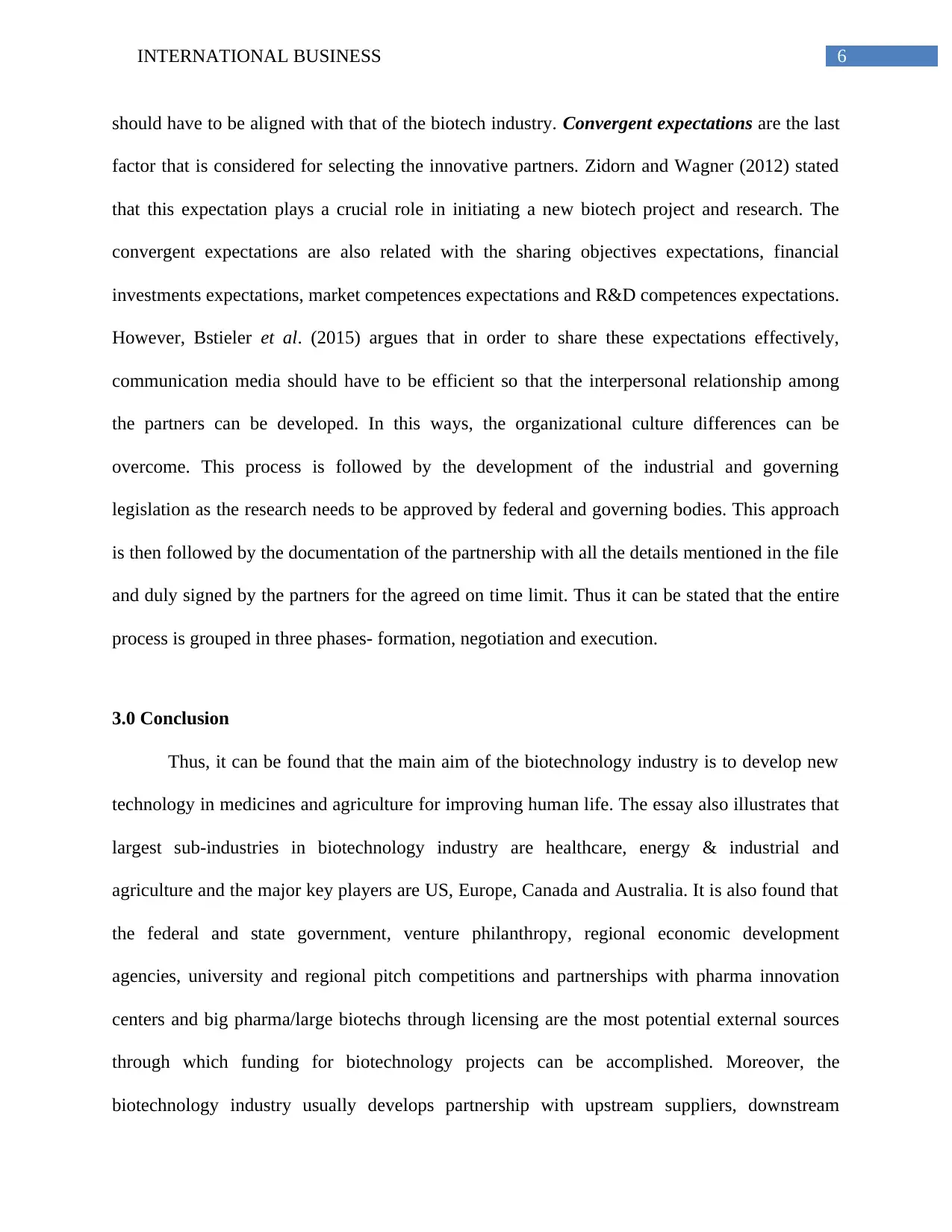
6INTERNATIONAL BUSINESS
should have to be aligned with that of the biotech industry. Convergent expectations are the last
factor that is considered for selecting the innovative partners. Zidorn and Wagner (2012) stated
that this expectation plays a crucial role in initiating a new biotech project and research. The
convergent expectations are also related with the sharing objectives expectations, financial
investments expectations, market competences expectations and R&D competences expectations.
However, Bstieler et al. (2015) argues that in order to share these expectations effectively,
communication media should have to be efficient so that the interpersonal relationship among
the partners can be developed. In this ways, the organizational culture differences can be
overcome. This process is followed by the development of the industrial and governing
legislation as the research needs to be approved by federal and governing bodies. This approach
is then followed by the documentation of the partnership with all the details mentioned in the file
and duly signed by the partners for the agreed on time limit. Thus it can be stated that the entire
process is grouped in three phases- formation, negotiation and execution.
3.0 Conclusion
Thus, it can be found that the main aim of the biotechnology industry is to develop new
technology in medicines and agriculture for improving human life. The essay also illustrates that
largest sub-industries in biotechnology industry are healthcare, energy & industrial and
agriculture and the major key players are US, Europe, Canada and Australia. It is also found that
the federal and state government, venture philanthropy, regional economic development
agencies, university and regional pitch competitions and partnerships with pharma innovation
centers and big pharma/large biotechs through licensing are the most potential external sources
through which funding for biotechnology projects can be accomplished. Moreover, the
biotechnology industry usually develops partnership with upstream suppliers, downstream
should have to be aligned with that of the biotech industry. Convergent expectations are the last
factor that is considered for selecting the innovative partners. Zidorn and Wagner (2012) stated
that this expectation plays a crucial role in initiating a new biotech project and research. The
convergent expectations are also related with the sharing objectives expectations, financial
investments expectations, market competences expectations and R&D competences expectations.
However, Bstieler et al. (2015) argues that in order to share these expectations effectively,
communication media should have to be efficient so that the interpersonal relationship among
the partners can be developed. In this ways, the organizational culture differences can be
overcome. This process is followed by the development of the industrial and governing
legislation as the research needs to be approved by federal and governing bodies. This approach
is then followed by the documentation of the partnership with all the details mentioned in the file
and duly signed by the partners for the agreed on time limit. Thus it can be stated that the entire
process is grouped in three phases- formation, negotiation and execution.
3.0 Conclusion
Thus, it can be found that the main aim of the biotechnology industry is to develop new
technology in medicines and agriculture for improving human life. The essay also illustrates that
largest sub-industries in biotechnology industry are healthcare, energy & industrial and
agriculture and the major key players are US, Europe, Canada and Australia. It is also found that
the federal and state government, venture philanthropy, regional economic development
agencies, university and regional pitch competitions and partnerships with pharma innovation
centers and big pharma/large biotechs through licensing are the most potential external sources
through which funding for biotechnology projects can be accomplished. Moreover, the
biotechnology industry usually develops partnership with upstream suppliers, downstream
Paraphrase This Document
Need a fresh take? Get an instant paraphrase of this document with our AI Paraphraser

7INTERNATIONAL BUSINESS
customers, horizontal competitors and research and university institutes. The selected process for
choosing innovation partners is analyzing innovativeness degree of partners, their financial
exposure, previous experience in alliances and effectiveness of convergent expectations.
customers, horizontal competitors and research and university institutes. The selected process for
choosing innovation partners is analyzing innovativeness degree of partners, their financial
exposure, previous experience in alliances and effectiveness of convergent expectations.
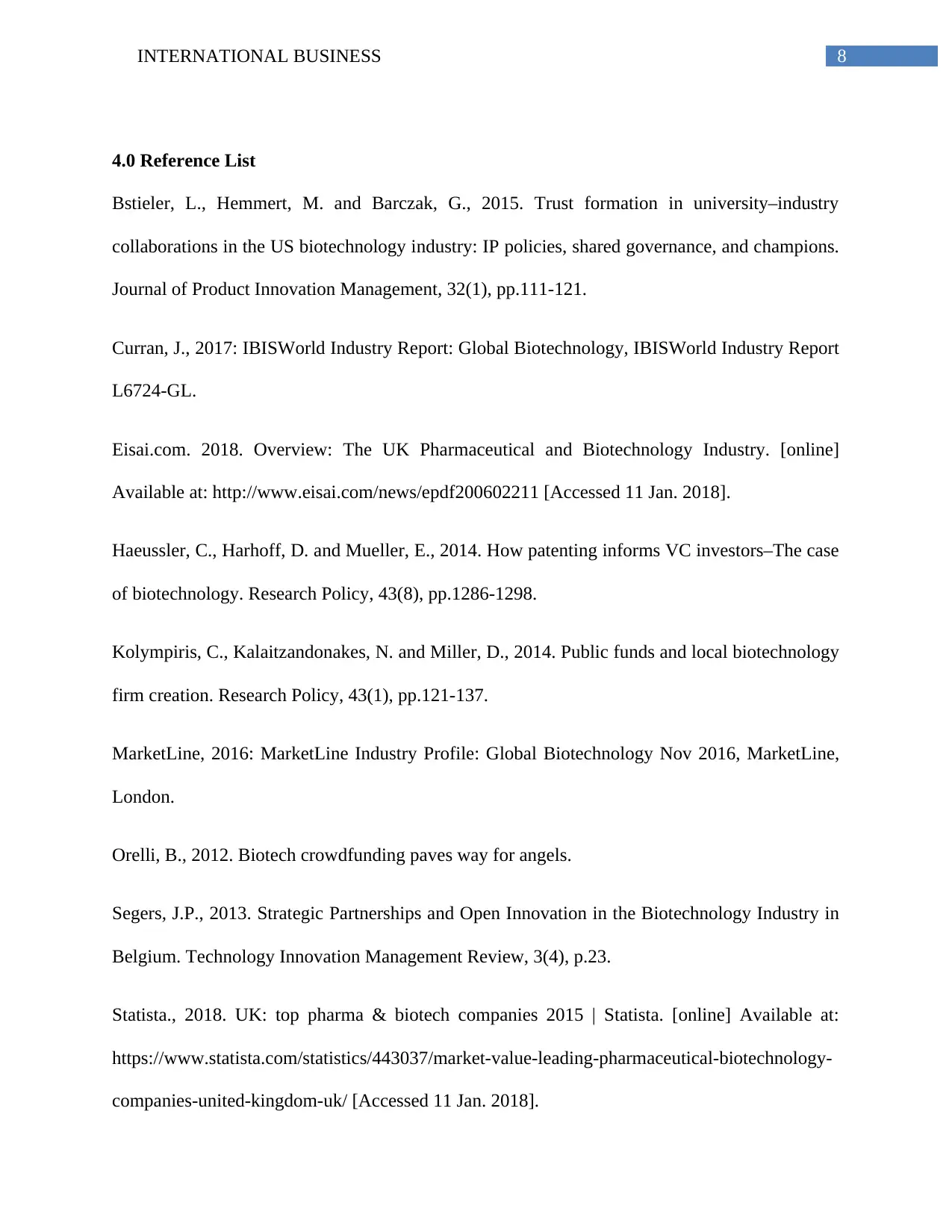
8INTERNATIONAL BUSINESS
4.0 Reference List
Bstieler, L., Hemmert, M. and Barczak, G., 2015. Trust formation in university–industry
collaborations in the US biotechnology industry: IP policies, shared governance, and champions.
Journal of Product Innovation Management, 32(1), pp.111-121.
Curran, J., 2017: IBISWorld Industry Report: Global Biotechnology, IBISWorld Industry Report
L6724-GL.
Eisai.com. 2018. Overview: The UK Pharmaceutical and Biotechnology Industry. [online]
Available at: http://www.eisai.com/news/epdf200602211 [Accessed 11 Jan. 2018].
Haeussler, C., Harhoff, D. and Mueller, E., 2014. How patenting informs VC investors–The case
of biotechnology. Research Policy, 43(8), pp.1286-1298.
Kolympiris, C., Kalaitzandonakes, N. and Miller, D., 2014. Public funds and local biotechnology
firm creation. Research Policy, 43(1), pp.121-137.
MarketLine, 2016: MarketLine Industry Profile: Global Biotechnology Nov 2016, MarketLine,
London.
Orelli, B., 2012. Biotech crowdfunding paves way for angels.
Segers, J.P., 2013. Strategic Partnerships and Open Innovation in the Biotechnology Industry in
Belgium. Technology Innovation Management Review, 3(4), p.23.
Statista., 2018. UK: top pharma & biotech companies 2015 | Statista. [online] Available at:
https://www.statista.com/statistics/443037/market-value-leading-pharmaceutical-biotechnology-
companies-united-kingdom-uk/ [Accessed 11 Jan. 2018].
4.0 Reference List
Bstieler, L., Hemmert, M. and Barczak, G., 2015. Trust formation in university–industry
collaborations in the US biotechnology industry: IP policies, shared governance, and champions.
Journal of Product Innovation Management, 32(1), pp.111-121.
Curran, J., 2017: IBISWorld Industry Report: Global Biotechnology, IBISWorld Industry Report
L6724-GL.
Eisai.com. 2018. Overview: The UK Pharmaceutical and Biotechnology Industry. [online]
Available at: http://www.eisai.com/news/epdf200602211 [Accessed 11 Jan. 2018].
Haeussler, C., Harhoff, D. and Mueller, E., 2014. How patenting informs VC investors–The case
of biotechnology. Research Policy, 43(8), pp.1286-1298.
Kolympiris, C., Kalaitzandonakes, N. and Miller, D., 2014. Public funds and local biotechnology
firm creation. Research Policy, 43(1), pp.121-137.
MarketLine, 2016: MarketLine Industry Profile: Global Biotechnology Nov 2016, MarketLine,
London.
Orelli, B., 2012. Biotech crowdfunding paves way for angels.
Segers, J.P., 2013. Strategic Partnerships and Open Innovation in the Biotechnology Industry in
Belgium. Technology Innovation Management Review, 3(4), p.23.
Statista., 2018. UK: top pharma & biotech companies 2015 | Statista. [online] Available at:
https://www.statista.com/statistics/443037/market-value-leading-pharmaceutical-biotechnology-
companies-united-kingdom-uk/ [Accessed 11 Jan. 2018].
⊘ This is a preview!⊘
Do you want full access?
Subscribe today to unlock all pages.

Trusted by 1+ million students worldwide
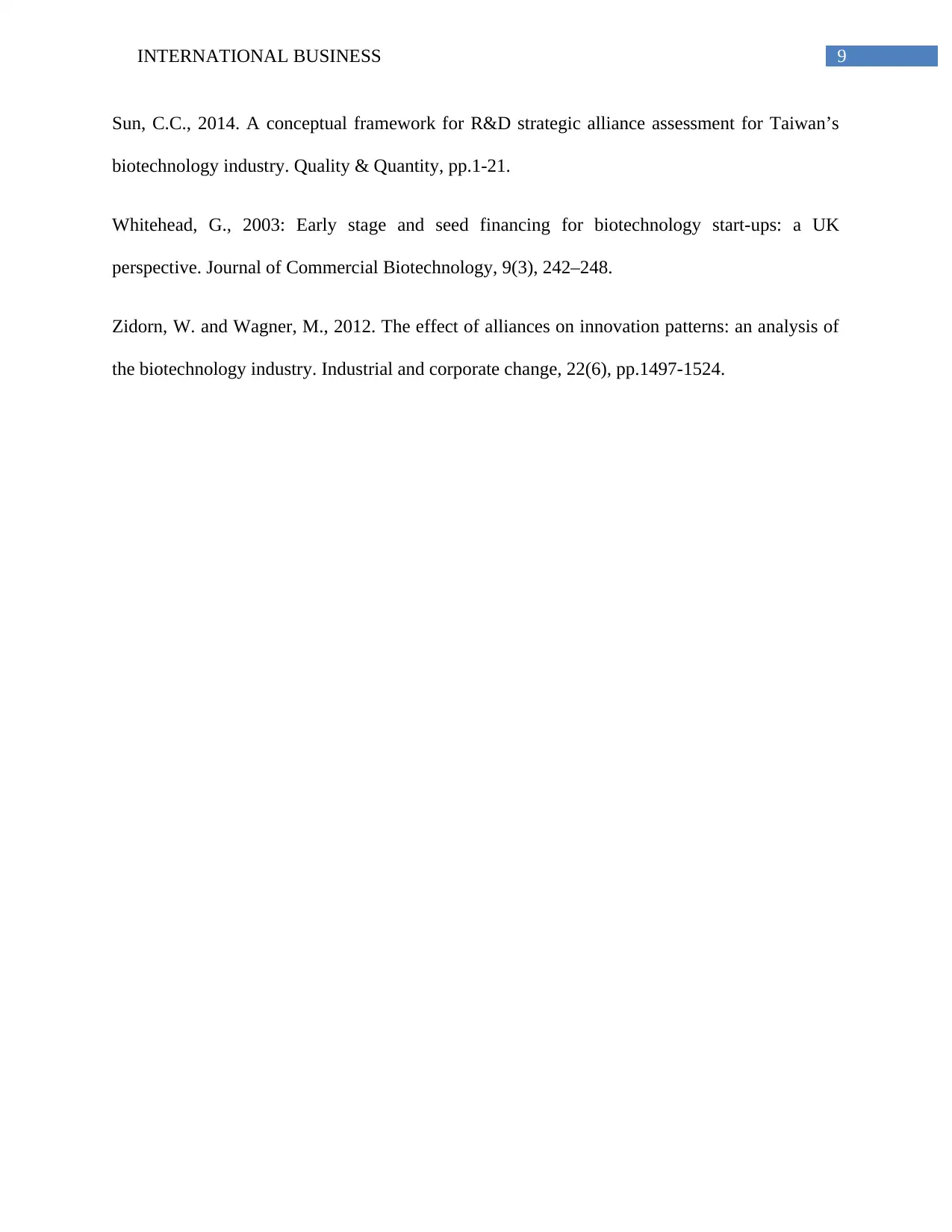
9INTERNATIONAL BUSINESS
Sun, C.C., 2014. A conceptual framework for R&D strategic alliance assessment for Taiwan’s
biotechnology industry. Quality & Quantity, pp.1-21.
Whitehead, G., 2003: Early stage and seed financing for biotechnology start-ups: a UK
perspective. Journal of Commercial Biotechnology, 9(3), 242–248.
Zidorn, W. and Wagner, M., 2012. The effect of alliances on innovation patterns: an analysis of
the biotechnology industry. Industrial and corporate change, 22(6), pp.1497-1524.
Sun, C.C., 2014. A conceptual framework for R&D strategic alliance assessment for Taiwan’s
biotechnology industry. Quality & Quantity, pp.1-21.
Whitehead, G., 2003: Early stage and seed financing for biotechnology start-ups: a UK
perspective. Journal of Commercial Biotechnology, 9(3), 242–248.
Zidorn, W. and Wagner, M., 2012. The effect of alliances on innovation patterns: an analysis of
the biotechnology industry. Industrial and corporate change, 22(6), pp.1497-1524.
1 out of 10
Your All-in-One AI-Powered Toolkit for Academic Success.
+13062052269
info@desklib.com
Available 24*7 on WhatsApp / Email
![[object Object]](/_next/static/media/star-bottom.7253800d.svg)
Unlock your academic potential
Copyright © 2020–2025 A2Z Services. All Rights Reserved. Developed and managed by ZUCOL.